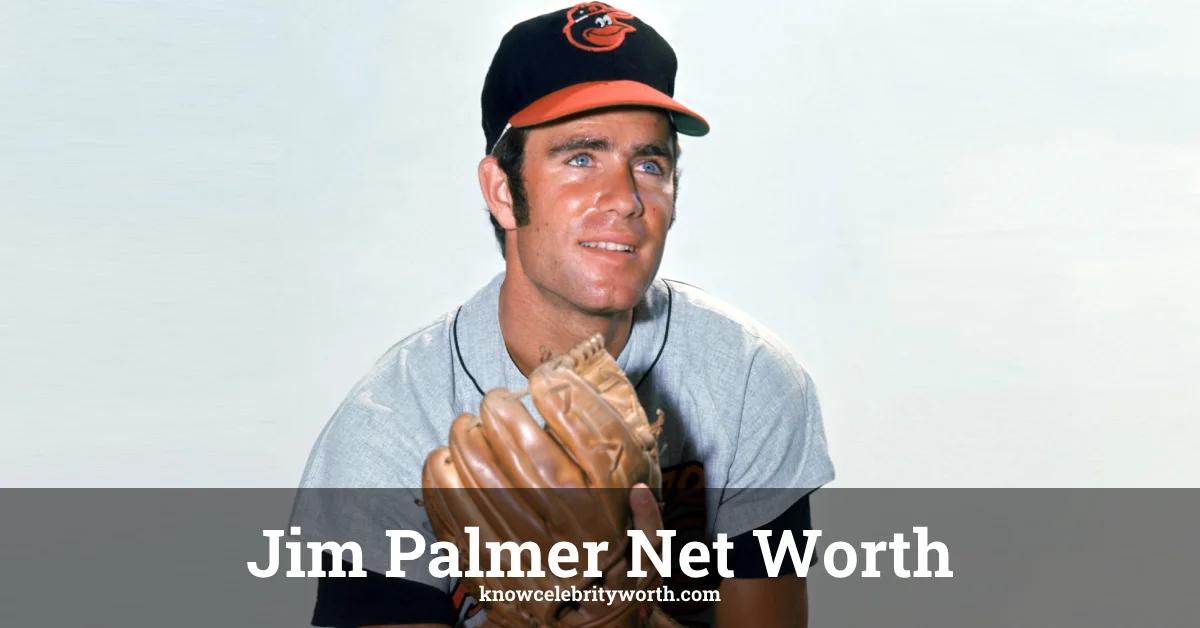Jim Palmer stands tall in baseball history as one of the greatest pitchers ever to take the mound. With his perfect form, devastating curveball, and three Cy Young Awards, Palmer cemented his legacy with the Baltimore Orioles. But how much wealth has the Hall of Fame pitcher actually built throughout his storied career and beyond? And what about the recent legal troubles that have put his finances in the spotlight?
This article dives into Jim Palmer’s net worth in 2025, exploring how the legendary pitcher built his fortune, his major income sources both during and after his playing days, and the recent fraud case that sent shockwaves through the baseball community.
Jim Palmer Net Worth
Jim Palmer’s net worth in 2025 stands at approximately $18-22 million. This figure represents the culmination of his earnings from his playing career, broadcasting work, endorsements, and investments over several decades.
Palmer’s journey to wealth began with his professional baseball career spanning from 1965 to 1984, all with the Baltimore Orioles. During his playing days, Palmer earned around $10 million in salary from his MLB contracts. While this may seem modest by today’s standards, these earnings were substantial for the era before free agency transformed baseball economics.
What truly sets Palmer apart was his longevity and consistent excellence. Playing all 19 seasons with the Orioles, Palmer won 268 games and posted a career 2.86 ERA, numbers that guaranteed his first-ballot Hall of Fame induction in 1990. This stellar performance on the field laid the foundation for his financial success.
Palmer’s career was marked by numerous achievements that boosted his earning potential. He won three Cy Young Awards (1973, 1975, and 1976), earned six All-Star selections, and helped the Orioles claim three World Series championships (1966, 1970, and 1983). These accomplishments not only increased his playing salary but also enhanced his market value for post-career opportunities.
After retirement, Palmer transitioned smoothly into broadcasting, becoming a fixture in the Orioles’ commentary booth. This broadcasting career has spanned several decades and provided Palmer with a steady income stream. Industry estimates suggest top baseball commentators can earn between $100,000 to $500,000 annually, depending on their market and experience level.
Jim Palmer’s Business Empire
Even during his playing days, Palmer showed a keen business sense that would help build his fortune. Most notably, he became famous as an underwear model for Jockey International in the 1970s and early 1980s, a pioneering move that broke new ground for athlete endorsements.
The Jockey campaign made Palmer a household name beyond baseball circles and reportedly paid him handsomely—estimated at several hundred thousand dollars annually during the peak of the campaign. This relationship lasted for about 15 years, proving exceptionally lucrative compared to most athlete endorsement deals of that era.
Palmer’s clean-cut image and articulate speaking style made him attractive to other brands as well. He secured partnerships with companies like Brut cologne and The Money Store. These endorsements significantly supplemented his baseball salary and continued to provide income even after his playing career ended.
In recent years, Palmer has maintained partnerships with several companies, including regional agreements with businesses in the Baltimore area that leverage his status as an Orioles legend. He’s been associated with local car dealerships, restaurants, and charitable organizations that pay for his name recognition and community goodwill.
Palmer has also earned money through autograph signings, baseball card shows, and speaking engagements. For Hall of Fame players like Palmer, these appearances can generate thousands of dollars per event, providing another steady income source throughout retirement.
Legal Battle
In 2023, Palmer’s finances unexpectedly became headline news when he filed a lawsuit against his longtime hairstylist, alleging fraud and theft amounting to over $7 million. This startling case revealed previously unknown details about Palmer’s financial situation and asset management.
According to court documents, Palmer claimed the hairstylist, who had become a trusted confidant over many years, had systematically stolen from him through unauthorized loans, forged signatures, and mismanagement of his assets. The lawsuit alleged this theft occurred over several years, with Palmer only discovering the extent of the misappropriation in 2022.
The case sent shockwaves through the baseball community and quickly went viral on social media platforms, including Reddit, where fans expressed shock that such a savvy public figure could allegedly fall victim to such extensive fraud. The lawsuit filings suggested the stolen funds represented a significant portion of Palmer’s lifetime savings.
Palmer’s legal team detailed how the alleged fraud worked: the hairstylist reportedly gained access to Palmer’s financial accounts, diverted funds to personal use, created fraudulent loan documents, and manipulated financial records to hide the theft. The complexity of the scheme highlighted vulnerabilities that even financially experienced individuals might face.
The lawsuit remains ongoing in 2025, with several preliminary rulings favoring Palmer’s claims. Financial experts following the case estimate that Palmer might recover a portion of the allegedly stolen funds, though legal costs and the difficulty of tracing some transactions may impact the final recovery amount.
This legal battle has had dual effects on Palmer’s net worth. On one hand, the alleged $7 million theft represents a significant hit to his lifetime earnings. On the other hand, the case has drawn attention to financial security issues facing retired athletes, leading to speaking opportunities and consulting roles for Palmer focused on financial literacy.
Fraud Case
The alleged $7+ million fraud represents a significant portion of Palmer’s lifetime earnings and has forced him to reassess his financial situation. Court documents reveal that Palmer had to make lifestyle adjustments while pursuing legal remedies.
Financial experts who have analyzed the case suggest the alleged theft might represent 25-35% of Palmer’s total wealth accumulation over his lifetime. This percentage highlights how significant the impact could be on his long-term financial security.
The legal battle itself carries substantial costs. High-profile fraud cases involving complex financial transactions often result in legal fees reaching hundreds of thousands of dollars. While Palmer likely has contingency arrangements with his attorneys, these costs still impact his bottom line.
The case has prompted Palmer to be more transparent about his finances than ever before. In several interviews since filing the lawsuit, he has discussed the importance of financial oversight and the dangers of trusting financial matters to individuals without proper verification systems.
The silver lining is that Palmer’s openness about the alleged fraud has resonated with many retired athletes and celebrities who face similar vulnerabilities. His willingness to discuss the case publicly has earned him respect and created new opportunities as a spokesman for financial security services targeted at athletes and entertainers.
Career

Palmer’s 19-season MLB career spans an interesting period in baseball economics. He began playing in 1965 when the average MLB salary was just $14,000. By the time he retired in 1984, the average had risen to $329,000, partly due to the advent of free agency in the mid-1970s.
As one of baseball’s premier pitchers, Palmer earned above-average salaries, especially in his prime years during the 1970s. His peak annual salary reportedly reached about $1 million in the early 1980s—a substantial sum for that era.
Palmer’s career earnings from baseball alone totaled approximately $10 million in nominal dollars. When adjusted for inflation to 2025 values, his baseball career earnings would equate to roughly $25-30 million in today’s purchasing power.
What makes Palmer’s financial story unique is that he played his entire career with one team, the Baltimore Orioles. This loyalty created strong ties with the Baltimore community that continued to pay dividends throughout his post-playing career through regional endorsements, speaking engagements, and his broadcasting role.
His broadcasting career has been remarkably stable and long-lasting. Palmer has worked as a color commentator for Orioles games for over 30 years, providing him with a steady income stream well into his seventies. This broadcasting role has kept him connected to the game and maintained his public profile, enhancing his value for endorsements and appearances.
Baseball and Other Income Sources
Unlike some athletes who struggle with the transition to post-playing careers, Palmer diversified his income sources effectively. Beyond broadcasting and traditional endorsements, he explored several other avenues for revenue.
Palmer authored several books about his baseball career and philosophy, including “Together We Were Eleven Foot Nine,” “Palmer’s Pitch,” and “High and Tight.” While not bestsellers, these books provided additional income and helped maintain his public profile between baseball seasons.
He also ventured into motivational speaking, commanding fees reported to be in the $10,000-$25,000 range per appearance. His speeches typically focus on teamwork, excellence, and overcoming obstacles—themes from his baseball career that resonate with corporate audiences.
Palmer’s investment portfolio, though not publicly detailed, reportedly includes real estate holdings in the Baltimore area and Florida, where he maintains a residence. These property investments have likely appreciated significantly over the decades, contributing to his overall net worth.
Some reports suggest Palmer has been involved with various business ventures over the years, including minority ownership stakes in restaurants and retail operations. While not his primary income source, these investments have diversified his portfolio beyond sports-related earnings.
Hall of Fame
Palmer’s financial success was built on his remarkable consistency and excellence on the field. Few pitchers in baseball history can match his achievements: three Cy Young Awards, six All-Star selections, four Gold Gloves, and three World Series championships.
What makes Palmer’s career trajectory special is that he overcame significant obstacles, including multiple arm injuries that threatened to derail his career prematurely. His comeback from these setbacks enhanced his reputation and marketability both during and after his playing days.
Jim Palmer debuted with the Orioles at just 19 years old in 1965 and pitched a complete game victory against the Yankees in the 1966 World Series at age 20. This early success established him as a rising star and set him on a path to financial security through baseball.
Throughout the 1970s, Palmer was arguably the most dominant pitcher in the American League. He won 20 or more games in eight seasons, an achievement that significantly boosted his salary and endorsement potential in an era before the massive contracts of today’s MLB.
Palmer’s perfect pitching mechanics made him both effective and photogenic. His model-like appearance and articulate interview style made him a natural for endorsements, most famously with Jockey underwear. These attributes allowed him to capitalize financially on his athletic success in ways many of his contemporaries could not.
By maintaining strong ties with the Orioles organization throughout his post-playing career, Palmer established a lifetime income source that has provided stability regardless of economic fluctuations. This organizational loyalty has paid off through broadcasting opportunities, team ambassador roles, and regional business partnerships.
Final Thoughts
As we look at Palmer’s net worth in 2025, perhaps the most remarkable aspect is how he built wealth through a diverse portfolio of income streams rather than relying solely on his baseball salary. This approach has allowed him to maintain financial stability for decades after his last professional pitch.
The recent fraud case, while personally devastating, has transformed Palmer into an unexpected advocate for financial literacy among athletes. His willingness to discuss the alleged betrayal publicly has helped others recognize similar warning signs in their own financial arrangements.
Palmer’s journey demonstrates both the opportunities and vulnerabilities that come with sports fame. His success leveraging his baseball reputation into broadcasting, endorsements, and speaking engagements shows the potential upside, while the fraud case highlights the unique risks celebrities face in managing their wealth.
As baseball salaries continue to skyrocket, Palmer’s career earnings and net worth may seem modest by contemporary standards. However, his financial longevity and diversification strategy provide valuable lessons for today’s athletes who earn far more but often struggle to maintain wealth beyond their playing days.
Despite the recent legal challenges, Palmer remains one of baseball’s most respected figures, with a financial legacy that reflects his disciplined, methodical approach to both pitching and personal finance. His story serves as both inspiration and caution for athletes navigating the complex world of wealth management.
